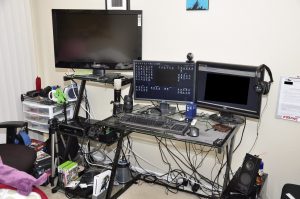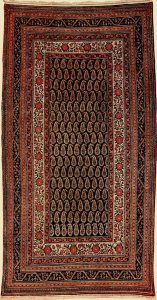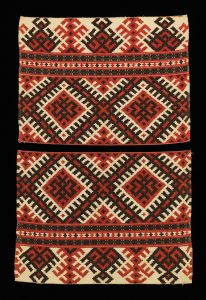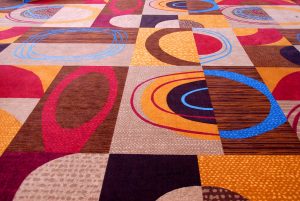Let's start with the basics
What Is Wallpaper?
The clue is in the name. Paper that goes on walls. Usually used as a form of decoration, and to add vibrancy to a homestead. Today we will learn facts, tips and techniques and traditional wallpaper methods that are still used today.
History Of Wallpaper
Believe it or not, 4000BC is when the first known instances of paper were introduced; we know it today as Papyrus; invented by the Ancient Egyptians.
Wallpaper is thought to have been invented by the Chinese, in around 200BC. The Chinese used decorated rice paper and glued it on their wall .
It was only around 100BC when the Chinese invented the technique of paper making that we know today, using waste fibers and flattening it out to create a sheet.
15th century france saw wallpaper come to the Monarchy at the time with Louis XI ordering 50 rolls of hand painted religious blue wallpaper.
The technique of hand painted wallpaper was never really going to take off and it took the arrival of the printing press for it to become a viable decoration for the home. The printing press ensuring quality and consistency.
The 16th century marks the start of wallpaper we know today.
How To Start Wallpapering
First you need to prepare, because, i know we all hate these words, but ‘preparation is key’.
Wallpaper is about 90% preparation 10% actually wallpapering. Make sure you have a clean, dust free room, and a straight flat wall.
You may need to get the wall skimmed to make sure it is a smooth surface, also make sure you have sanded, or filled in any gaps, as these will show through when you start to wallpaper.
Got that ? Brilliant. However, if your wall still has old paper on it, you may want to remove it . you can paper over wallpaper if it is smooth enough, and isn't prone to falling off.
How Many Times Can You Wallpaper Over Wallpaper?
Pretty much as many as you want, as long as it isn't peeling off the wall. If it ain’t broke, don’t fix it. I recently flipped a house that had some victorian style paper on it 10 layers deep!
How To Remove Wallpaper.
So you have decided this paper is unsalvageable. Its faded 70s pattern just isn't cutting it anymore in the 21st century. Removing wallpaper is a simple task, and can be quite therapeutic.
You will need :
Wallpaper scraper
Bucket of water
Wallpaper steamer
Instructions:
Turn on your steamer and let it get up to temperature
Once it gets up to temperature, place it on a patch of the wallpaper.
Wait approximately 10 seconds, then use your scraper to scrape the paper away.
Repeat till done
The wallpaper can be harder/easier to come
off so it's really a matter of trial and error to find out the best way of getting it off. Sometimes people find the paper simply falls off in big sheets. Other times it can be almost like melded in with the wall . It can depend on a number of factors.
Somepeople opt for wallpaper remover homemade, instead of the steam method. I have found this very useful if there is wallpaper adhesive that won't come off.
You may want to try this
Vinegar Wallpaper Removal Recipe:
Simply mix warm water and white vinegar in a bucket
Fill into a spray bottle or a sponge
Spray on wall. This will dissolve the adhesive if left for 10+ minutes at a time.
Make sure you scrape it off while it is still wet, or it may just be dry again.
How To Remove Wallpaper With Fabric Softener
Similar to the vinegar method; make sure you wear gloves.
Soak warm water and Fabric softener until it forms a mixture
Pour onto a sponge.
Sponge the wall & let this soak into the paper.
Scrape off after 10 minutes.
Make sure to keep the water warm as it loosens the adhesive faster than cold water.
How To Remove Wallpaper Border
This is the same as wallpaper. It could be slightly trickier as the adhesive may have set, but if you use my advice of the vinegar/fabric softener solution, it should come off in no time! If you are in doubt you could use your steamer.
If you score some lines in a particularly tricky section this will help the steam penetrate through the paper to the wall and loosen it from the inside.
How To Measure A Room
Let's start with the basics, because this is a really important step that a lot of people miss. Grab a tape measure and get someone to hold the other end, then get the length of the walls of the room. Once you have this figure, add them all up . This is the length of all of the walls in the room.
How To Measure For Wallpaper
If you measured your room, great you are almost there. This is similar, but you are going to want to calculate the area of the walls too so you can more accurately measure how many rolls of wallpaper you will need. To calculate square feet you need to measure the height of the room and multiply it by the length. To calculate square meters of a room you need to do the same but make sure you are working in whatever unit of measurement you want to measure in.
How Many Rolls Of wallpaper for an average room?
Some people will say 8-10 but I will say this - there is no ‘average room’ one person's average is very different to another person. So you need to make sure you measure wallpaper properly , accurately and efficiently to your own room specification.
How Many Rolls Of Wallpaper?
Now you have the square feet or meters. You can guesstimate how many rolls you will need. I will say guesstimate as i recommend you always purchase a little over how many you think you'll need incase of emergencies or anything going wrong. Get the wallpaper dimensions and simply divide by the wall dimensions, this will give you an exact number. Some people recommend you round it up by a roll just to be on the safe side.
How To Cut Wallpaper Straight.
You may want to know about how to cut the wallpaper straight. Simply get a T Square, or a spirit level when you cut your paper. Make sure it is at a 90 degree angle to your paper. You could use a stanley knife or some sharp scissors to make the cut.
How To Make Wallpaper Paste
You can buy wallpaper adhesive. But for a cheaper more natural method, you could make some of your own wheat paste, still used in traditional wallpaper methods around the world.
Simply measure 5 cups of wheat flour and 1 cup of sugar and stir.
Heat the mixture on stove
Add 1 gallon of water, using a whisk to work out all the lumps.
Cook until mixture begins to look clear.
Remove from heat and cool to room temperature.
There are have perfect wallpaper paste!
How To Hang PrePasted Wallpaper.
You may want to know how to hang wallpaper. There are a lot of different ways to do this .
Old methods require the paper to be pasted then stuck onto the wall, and a more modern method is pasting the wall , then sticking the paper on. There are no incorrect ways to do this.
Hanging prepasted wallpaper is easy, simply draw a 90 degree angle on your wall. This will be your guide to keeping the paper straight.
Lay the paper on the wall and use a clean sponge with warm soapy water to stick it down. Ensure the corners are secure. Repeat this until you get to a corner
hanging wallpaper on a pasted wall is exactly the same method.
How To Remove Wallpaper Glue
You may notice glue seeping out from your paper. Don't worry this is not going to ruin your paper ,and too much glue is better than too little when it comes to papering, but be aware, when this glue dries, it will be a pain to remove so it is bes tot tr,pbr oy sd soon as you have done it . Try and remove with a warm soapy sponge
How To Wallpaper A Corner
Now we are approaching a pesky corner. A lot of people are scared when they ask me ‘how to wallpaper corners’ because they are afraid to mess up their wallpapering so far. But im here to tell you it isn't as hard or scary as you think !
Never wrap your paper more than 0.5 inches around an inside corner. The natural drying of the glue means the paper will shrink and pull back resulting in possible wrinkling or the paper not sticking to the wall .
Instead, make a seam with the paper, as to disguise the natural overlap.
This may take some getting used to and getting it perfect, but it is true that the corners of a room are where the human eye is drawn first, so it is best to get these bits perfect and the rest will follow!
How To Wallpaper Around Pipes
Wallpapering around pipes is easy, cut the paper to size, and then simply score out notches where the pipes go. You can alternately draw an outline with a pencil and peel the paper back slightly and cut the paper to size this way. It entirely depends on the size and shape of the paper and the pipes as to which direction you want to go down.
Why Wallpaper?
Hopefully I have given you some insight into how to wallpaper and how easy it is once you have got the ‘hang’ of it… (pun intended). All jokes aside I think wallpapering is an invaluable life skill and it can brighten up the dullest room. Knowing how to wallpaper yourself also can save a lot of money, time and effort in finding a reliable professional.
The post How To Measure For Wallpaper – and Other Wallpaper FAQ’s Find more on: www.adetailedpalette.com
via A Detailed Palette - Feed
https://www.adetailedpalette.com/how-to-measure-for-wallpaper-and-other-wallpaper-faqs/







